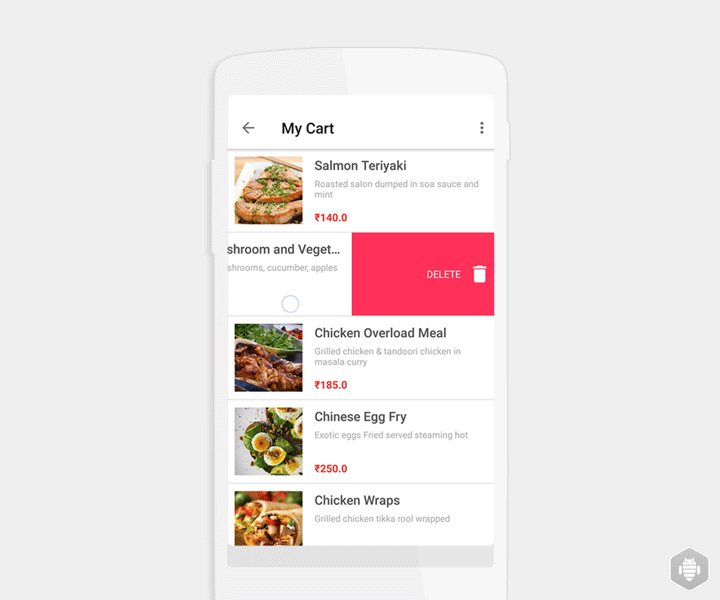Introduction of RecyclerView is the best thing ever happen to android world. You can create stunningly beautiful lists and grids using the RecyclerView. Lot of us are very familiar in rendering the basic lists when the UI is very simple. But it comes to more complex lists that contains multiple UI elements along with animations, not everybody can achieve the final output they are looking for.
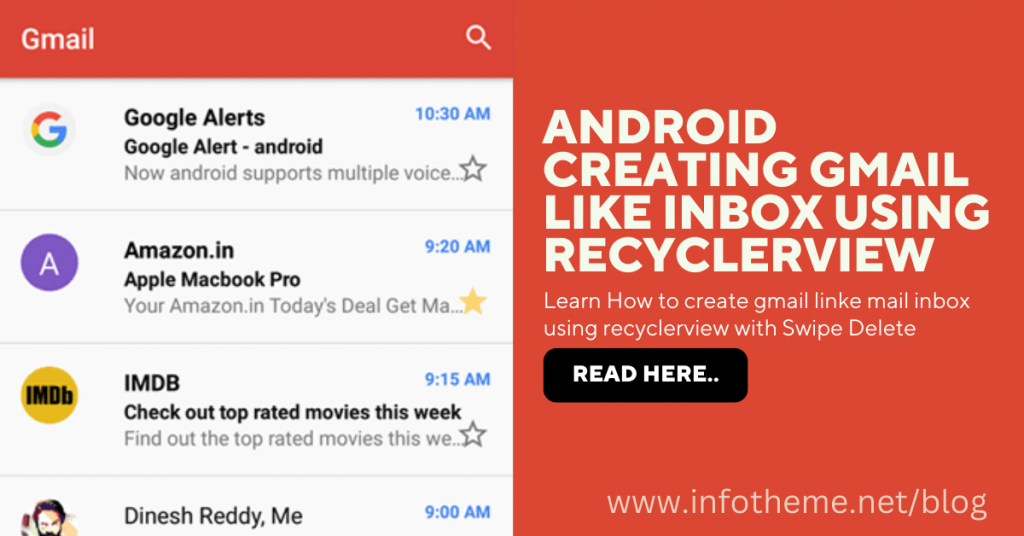
This article aims to improvise your knowledge on RecyclerView by taking an example of Gmail style inbox that contains the complex list design with interactive animations.
Contents
1. Overview
The desired output like Gmail app can’t be achieved just with the RecyclerView alone. It needs combination of other few android concepts. Overall we gonna use the below mentioned components to get the finest appearance and functionality.
> RecyclerView
The basic component required for this app is RecyclerView as our primary task is to display the data in list fashion. The appearance of the list is customized just like Gmail app displaying a thumbnail icon, three line message, timestamp and a star icon to mark the message as important.
> SwipeRefreshLayout
In order to refresh the inbox, SwipeRefreshLayout is wrapped around the RecyclerView. This article doesn’t explains the persistence of the data. So the inbox will be reset to initial state up on refresh.
> ActionMode
ActionMode is used to display the contextual toolbar when a row is long pressed in the list. This enables us to provide set of alternative toolbar icons when the recycler view is in multiple choice mode. Here we provide delete option to delete the selected messages.
> Object Animators
Object Animators allows us to animate a target element. In this we use the object animators to perform the Flip Animation of list thumbnail icon when a row is long pressed.
> Retrofit
In a production app, all the inbox messages are dynamic i.e they are fetched from a REST API. To demonstrate that, I have used a JSON url to list the messages. We use Retrofit library to fetch and deserialize the JSON.
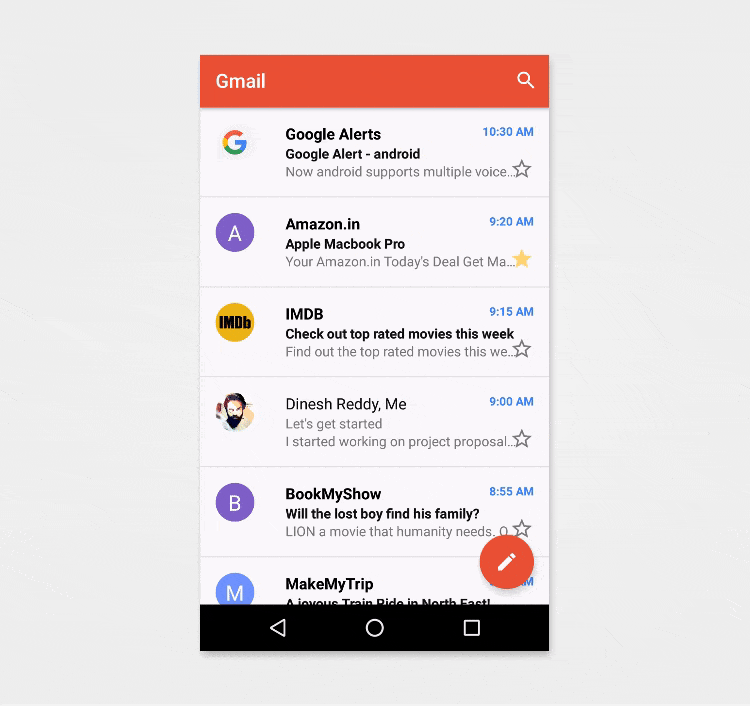
2. Sample JSON for Inbox Messages
I have created an endpoint which serves the inbox messages in a JSON format. The JSON contains the information like profile picture, from, subject, message, timestamp and other details necessary to render the list. In realtime this json should be generated from a database using any server side language.
https://demoapi.infotheme.net/gmail/json/inbox.json
[
{
"id": 1,
"isImportant": false,
"picture": "https://demoapi.infotheme.net/gmail/json/google.png",
"from": "Google Alerts",
"subject": "Google Alert - android",
"message": "Android N update is released to Nexus Family!",
"timestamp": "10:30 AM",
"isRead": false
},
.
.
.
]
3. Creating New Project
We’ll start by creating new project in Android Studio and do the basic setup required. Below is the final project structure I have planned for this article. This post seems to be lengthy but trust me this will enhance your knowledge and you will see surprising results when you reach to the bottom.
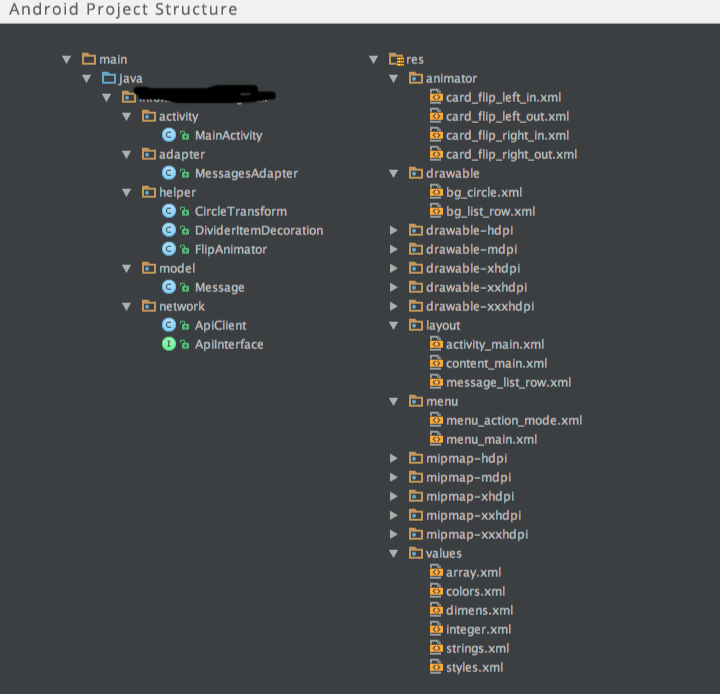
1. Create a new project in Android Studio from File ⇒ New Project and fill the project details. While creating the project, I have selected the Basic Activity as default activity to get the Toolbar, FAB and other elements.
2. Open build.gradle located under app module and add RecyclerView, Retrofit and Glide dependencies and Sync the project.
dependencies {
compile fileTree(dir: 'libs', include: ['*.jar'])
androidTestCompile('com.android.support.test.espresso:espresso-core:2.2.2', {
exclude group: 'com.android.support', module: 'support-annotations'
})
compile 'com.android.support:appcompat-v7:24.2.1'
compile 'com.android.support.constraint:constraint-layout:1.0.0-alpha7'
compile 'com.android.support:design:24.2.1'
testCompile 'junit:junit:4.12'
// RecyclerView
compile 'com.android.support:recyclerview-v7:24.2.1'
// retrofit, gson
compile 'com.google.code.gson:gson:2.6.2'
compile 'com.squareup.retrofit2:retrofit:2.0.2'
compile 'com.squareup.retrofit2:converter-gson:2.0.2'
// glide
compile 'com.github.bumptech.glide:glide:3.7.0'
}
3. res folder contains all the necessary icons required for the RecyclerView and Toolbar.
4. Add the below colors, strings and dimens to respective files.
colors.xml
colors.xml
<?xml version="1.0" encoding="utf-8"?>
<resources>
<color name="colorPrimary">#db4437</color>
<color name="colorPrimaryDark">#b93221</color>
<color name="colorAccent">#FFFFFF</color>
<color name="from">#000000</color>
<color name="subject">#111111</color>
<color name="timestamp">#4285f4</color>
<color name="message">#7a7a7a</color>
<color name="icon_tint_normal">#7a7a7a</color>
<color name="icon_tint_selected">#fed776</color>
<color name="row_activated">#e0e0e0</color>
<color name="bg_action_mode">#757575</color>
<color name="bg_circle_default">#666666</color>
</resources>
dimens.xml
<resources>
<dimen name="fab_margin">16dp</dimen>
<dimen name="padding_list_row">16dp</dimen>
<dimen name="messages_padding_left">72dp</dimen>
<dimen name="icon_width_height">40dp</dimen>
<dimen name="msg_text_primary">16sp</dimen>
<dimen name="msg_text_secondary">14sp</dimen>
<dimen name="icon_star">25dp</dimen>
<dimen name="icon_text">22dp</dimen>
<dimen name="timestamp">12dp</dimen>
</resources>
strings.xml
<resources>
<string name="app_name">Gmail</string>
<string name="action_settings">Settings</string>
<string name="action_search">Search</string>
<string name="action_delete">Delete</string>
</resources>
5. Open styles.xml and add the below styles. Here windowActionModeOverlay is added to overlap the ActionMode onto Toolbar.
styles.xml
<resources>
<!-- Base application theme. -->
<style name="AppTheme" parent="Theme.AppCompat.Light.DarkActionBar">
<!-- Customize your theme here. -->
<item name="colorPrimary">@color/colorPrimary</item>
<item name="colorPrimaryDark">@color/colorPrimaryDark</item>
<item name="colorAccent">@color/colorAccent</item>
</style>
<style name="AppTheme.NoActionBar">
<item name="windowActionBar">false</item>
<item name="windowNoTitle">true</item>
<item name="windowActionModeOverlay">true</item>
<item name="android:actionModeBackground">@color/bg_action_mode</item>
</style>
<style name="AppTheme.AppBarOverlay" parent="ThemeOverlay.AppCompat.Dark.ActionBar" />
<style name="AppTheme.PopupOverlay" parent="ThemeOverlay.AppCompat.Light" />
</resources>
6. As we are going to make network calls we need INTERNET permission in the manifest file. Open AndroidManifest.xml and add the permission.
AndroidManifest.xml
<?xml version="1.0" encoding="utf-8"?>
<manifest xmlns:android="http://schemas.android.com/apk/res/android"
package="net.infotheme.gmail">
<uses-permission android:name="android.permission.INTERNET" />
<application
android:allowBackup="true"
android:icon="@mipmap/ic_launcher"
android:label="@string/app_name"
android:supportsRtl="true"
android:theme="@style/AppTheme">
<activity
android:name=".activity.MainActivity"
android:label="@string/app_name"
android:theme="@style/AppTheme.NoActionBar">
<intent-filter>
<action android:name="android.intent.action.MAIN" />
<category android:name="android.intent.category.LAUNCHER" />
</intent-filter>
</activity>
</application>
</manifest>
7. Create five packages named activity, adapter, helper, model and network. We use these packages to keep the project organized. Once the packages are created, move your MainActivity to activity package.
4. Adding Retrofit – Fetching JSON
Now our project have the basic resources ready. Let’s add the network layer by using the Retrofit library. If you are new to Retrofit, I strongly suggest you go through my previous article about Retrofit.
8. Under model package, create a class named Message.java. This POJO class is used to deserialize the json while parsing.
Message.java
package net.infotheme.gmail.model;
public class Message {
private int id;
private String from;
private String subject;
private String message;
private String timestamp;
private String picture;
private boolean isImportant;
private boolean isRead;
private int color = -1;
public Message() {
}
public int getId() {
return id;
}
public void setId(int id) {
this.id = id;
}
public String getFrom() {
return from;
}
public void setFrom(String from) {
this.from = from;
}
public String getSubject() {
return subject;
}
public void setSubject(String subject) {
this.subject = subject;
}
public String getMessage() {
return message;
}
public void setMessage(String message) {
this.message = message;
}
public String getTimestamp() {
return timestamp;
}
public void setTimestamp(String timestamp) {
this.timestamp = timestamp;
}
public boolean isImportant() {
return isImportant;
}
public void setImportant(boolean important) {
isImportant = important;
}
public String getPicture() {
return picture;
}
public void setPicture(String picture) {
this.picture = picture;
}
public boolean isRead() {
return isRead;
}
public void setRead(boolean read) {
isRead = read;
}
public int getColor() {
return color;
}
public void setColor(int color) {
this.color = color;
}
}
9. Under network package, create a new class named ApiClient.java. This class creates the static retrofit instance.
ApiClient.java
package net.infotheme.gmail.network;
import retrofit2.Retrofit;
import retrofit2.converter.gson.GsonConverterFactory;
public class ApiClient {
public static final String BASE_URL = "https://demoapi.infotheme.net/gmail/json/";
private static Retrofit retrofit = null;
public static Retrofit getClient() {
if (retrofit == null) {
retrofit = new Retrofit.Builder()
.baseUrl(BASE_URL)
.addConverterFactory(GsonConverterFactory.create())
.build();
}
return retrofit;
}
}
10. Under network package, create a new class named ApiInterface.java. This class contains the rest api endpoints and the type of response it is expecting. In our case we have only one endpoint i.e inbox.json
ApiInterface.java
package net.infotheme.gmail.network;
import java.util.List;
import net.infotheme.gmail.model.Message;
import retrofit2.Call;
import retrofit2.http.GET;
public interface ApiInterface {
@GET("inbox.json")
Call<List<Message>> getInbox();
}
This completes the retrofit integration. Now let’s add few helper classes those helps in rendering the list.
11. Under helper package, create a class named CircleTransform.java. This class is used to display the thumbnail image in circular shape using the Glide library.
CircleTransform.java
package net.infotheme.gmail.helper;
import android.content.Context;
import android.graphics.Bitmap;
import android.graphics.BitmapShader;
import android.graphics.Canvas;
import android.graphics.Paint;
import com.bumptech.glide.load.engine.bitmap_recycle.BitmapPool;
import com.bumptech.glide.load.resource.bitmap.BitmapTransformation;
public class CircleTransform extends BitmapTransformation {
public CircleTransform(Context context) {
super(context);
}
@Override protected Bitmap transform(BitmapPool pool, Bitmap toTransform, int outWidth, int outHeight) {
return circleCrop(pool, toTransform);
}
private static Bitmap circleCrop(BitmapPool pool, Bitmap source) {
if (source == null) return null;
int size = Math.min(source.getWidth(), source.getHeight());
int x = (source.getWidth() - size) / 2;
int y = (source.getHeight() - size) / 2;
// TODO this could be acquired from the pool too
Bitmap squared = Bitmap.createBitmap(source, x, y, size, size);
Bitmap result = pool.get(size, size, Bitmap.Config.ARGB_8888);
if (result == null) {
result = Bitmap.createBitmap(size, size, Bitmap.Config.ARGB_8888);
}
Canvas canvas = new Canvas(result);
Paint paint = new Paint();
paint.setShader(new BitmapShader(squared, BitmapShader.TileMode.CLAMP, BitmapShader.TileMode.CLAMP));
paint.setAntiAlias(true);
float r = size / 2f;
canvas.drawCircle(r, r, r, paint);
return result;
}
@Override public String getId() {
return getClass().getName();
}
}
12. Under helper package, create another class named DividerItemDecoration.java. This helps in adding divider lines in recycler view.
DividerItemDecoration
package net.infotheme.gmail.helper;
import android.content.Context;
import android.content.res.TypedArray;
import android.graphics.Canvas;
import android.graphics.Rect;
import android.graphics.drawable.Drawable;
import android.support.v7.widget.LinearLayoutManager;
import android.support.v7.widget.RecyclerView;
import android.view.View;
public class DividerItemDecoration extends RecyclerView.ItemDecoration {
private static final int[] ATTRS = new int[]{
android.R.attr.listDivider
};
public static final int HORIZONTAL_LIST = LinearLayoutManager.HORIZONTAL;
public static final int VERTICAL_LIST = LinearLayoutManager.VERTICAL;
private Drawable mDivider;
private int mOrientation;
public DividerItemDecoration(Context context, int orientation) {
final TypedArray a = context.obtainStyledAttributes(ATTRS);
mDivider = a.getDrawable(0);
a.recycle();
setOrientation(orientation);
}
public void setOrientation(int orientation) {
if (orientation != HORIZONTAL_LIST && orientation != VERTICAL_LIST) {
throw new IllegalArgumentException("invalid orientation");
}
mOrientation = orientation;
}
@Override
public void onDrawOver(Canvas c, RecyclerView parent, RecyclerView.State state) {
if (mOrientation == VERTICAL_LIST) {
drawVertical(c, parent);
} else {
drawHorizontal(c, parent);
}
}
public void drawVertical(Canvas c, RecyclerView parent) {
final int left = parent.getPaddingLeft();
final int right = parent.getWidth() - parent.getPaddingRight();
final int childCount = parent.getChildCount();
for (int i = 0; i < childCount; i++) {
final View child = parent.getChildAt(i);
final RecyclerView.LayoutParams params = (RecyclerView.LayoutParams) child
.getLayoutParams();
final int top = child.getBottom() + params.bottomMargin;
final int bottom = top + mDivider.getIntrinsicHeight();
mDivider.setBounds(left, top, right, bottom);
mDivider.draw(c);
}
}
public void drawHorizontal(Canvas c, RecyclerView parent) {
final int top = parent.getPaddingTop();
final int bottom = parent.getHeight() - parent.getPaddingBottom();
final int childCount = parent.getChildCount();
for (int i = 0; i < childCount; i++) {
final View child = parent.getChildAt(i);
final RecyclerView.LayoutParams params = (RecyclerView.LayoutParams) child
.getLayoutParams();
final int left = child.getRight() + params.rightMargin;
final int right = left + mDivider.getIntrinsicHeight();
mDivider.setBounds(left, top, right, bottom);
mDivider.draw(c);
}
}
@Override
public void getItemOffsets(Rect outRect, View view, RecyclerView parent, RecyclerView.State state) {
if (mOrientation == VERTICAL_LIST) {
outRect.set(0, 0, 0, mDivider.getIntrinsicHeight());
} else {
outRect.set(0, 0, mDivider.getIntrinsicWidth(), 0);
}
}
}
5. Generating Random Material Color
Another exciting thing you would come across here is assigning a random background color to each row icon. To achieve this we need to predefine set of material colors in an array and choose a random color while RecyclerView is prepared. Thanks to daniellevass for providing such an useful color codes.
13. Create an xml named array.xml under res ⇒ values. This xml contains few material colors thouse would be loaded randomly in list.
array.xml
<?xml version="1.0" encoding="utf-8"?>
<resources>
<array name="mdcolor_400">
<item name="red_400" type="color">#e84e40</item>
<item name="pink_400" type="color">#ec407a</item>
<item name="purple_400" type="color">#ab47bc</item>
<item name="deep_purple_400" type="color">#7e57c2</item>
<item name="indigo_400" type="color">#5c6bc0</item>
<item name="blue_400" type="color">#738ffe</item>
<item name="light_blue_400" type="color">#29b6f6</item>
<item name="cyan_400" type="color">#26c6da</item>
<item name="teal_400" type="color">#26a69a</item>
<item name="green_400" type="color">#2baf2b</item>
<item name="light_green_400" type="color">#9ccc65</item>
<item name="lime_400" type="color">#d4e157</item>
<item name="yellow_400" type="color">#ffee58</item>
<item name="orange_400" type="color">#ffa726</item>
<item name="deep_orange_400" type="color">#ff7043</item>
<item name="brown_400" type="color">#8d6e63</item>
<item name="grey_400" type="color">#bdbdbd</item>
<item name="blue_grey_400" type="color">#78909c</item>
</array>
<array name="mdcolor_500">
<item name="red_500" type="color">#e51c23</item>
<item name="pink_500" type="color">#e91e63</item>
<item name="purple_500" type="color">#9c27b0</item>
<item name="deep_purple_500" type="color">#673ab7</item>
<item name="indigo_500" type="color">#3f51b5</item>
<item name="blue_500" type="color">#5677fc</item>
<item name="light_blue_500" type="color">#03a9f4</item>
<item name="cyan_500" type="color">#00bcd4</item>
<item name="teal_500" type="color">#009688</item>
<item name="green_500" type="color">#259b24</item>
<item name="light_green_500" type="color">#8bc34a</item>
<item name="lime_500" type="color">#cddc39</item>
<item name="yellow_500" type="color">#ffeb3b</item>
<item name="orange_500" type="color">#ff9800</item>
<item name="deep_orange_500" type="color">#ff5722</item>
<item name="brown_500" type="color">#795548</item>
<item name="grey_500" type="color">#9e9e9e</item>
<item name="blue_grey_500" type="color">#607d8b</item>
</array>
</resources>
To load these colors randomly, the following function can be used. You will see how to use this function shortly.
private int getRandomMaterialColor(String typeColor) {
int returnColor = Color.GRAY;
int arrayId = getResources().getIdentifier("mdcolor_" + typeColor, "array", getPackageName());
if (arrayId != 0) {
TypedArray colors = getResources().obtainTypedArray(arrayId);
int index = (int) (Math.random() * colors.length());
returnColor = colors.getColor(index, Color.GRAY);
colors.recycle();
}
return returnColor;
}
6. Flip Animation using Object Animators
If you observe the gmail app, when you long press and selects a row, the thumbnail icon will be animated in a flip motion showing other side of the icon. We can do the same using the ObjectAnimator concepts. Carefully create the below mentioned files in your project.
14. Under res ⇒ values, create an xml named integer.xml. Here we define the animation durations.
integer.xml
<?xml version="1.0" encoding="utf-8"?>
<resources>
<integer name="card_flip_time_full">500</integer>
<integer name="card_flip_time_half">200</integer>
</resources>
15. Create a folder named animator under res folder. In this directory we place all the xml resources related to animations.
16. Under animator, create four xml files named card_flip_left_in.xml,
card_flip_left_out.xml,
card_flip_right_in.xml
and card_flip_right_out.xml.
card_flip_left_in.xml
<set xmlns:android="http://schemas.android.com/apk/res/android">
<!-- Before rotating, immediately set the alpha to 0. -->
<objectAnimator
android:valueFrom="1.0"
android:valueTo="0.0"
android:propertyName="alpha"
android:duration="0" />
<!-- Rotate. -->
<objectAnimator
android:valueFrom="-180"
android:valueTo="0"
android:propertyName="rotationY"
android:interpolator="@android:interpolator/accelerate_decelerate"
android:duration="@integer/card_flip_time_full" />
<!-- Half-way through the rotation (see startOffset), set the alpha to 1. -->
<objectAnimator
android:valueFrom="0.0"
android:valueTo="1.0"
android:propertyName="alpha"
android:startOffset="@integer/card_flip_time_half"
android:duration="1" />
</set>
card_flip_left_out.xml
<set xmlns:android="http://schemas.android.com/apk/res/android">
<!-- Rotate. -->
<objectAnimator
android:valueFrom="0"
android:valueTo="180"
android:propertyName="rotationY"
android:interpolator="@android:interpolator/accelerate_decelerate"
android:duration="@integer/card_flip_time_full" />
<!-- Half-way through the rotation (see startOffset), set the alpha to 0. -->
<objectAnimator
android:valueFrom="1.0"
android:valueTo="0.0"
android:propertyName="alpha"
android:startOffset="@integer/card_flip_time_half"
android:duration="1" />
</set>
card_flip_right_in.xml
<set xmlns:android="http://schemas.android.com/apk/res/android">
<!-- Before rotating, immediately set the alpha to 0. -->
<objectAnimator
android:valueFrom="1.0"
android:valueTo="0.0"
android:propertyName="alpha"
android:duration="0" />
<!-- Rotate. -->
<objectAnimator
android:valueFrom="180"
android:valueTo="0"
android:propertyName="rotationY"
android:interpolator="@android:interpolator/accelerate_decelerate"
android:duration="@integer/card_flip_time_full" />
<!-- Half-way through the rotation (see startOffset), set the alpha to 1. -->
<objectAnimator
android:valueFrom="0.0"
android:valueTo="1.0"
android:propertyName="alpha"
android:startOffset="@integer/card_flip_time_half"
android:duration="1" />
</set>
card_flip_right_out.xml
<set xmlns:android="http://schemas.android.com/apk/res/android">
<!-- Rotate. -->
<objectAnimator
android:valueFrom="0"
android:valueTo="-180"
android:propertyName="rotationY"
android:interpolator="@android:interpolator/accelerate_decelerate"
android:duration="@integer/card_flip_time_full" />
<!-- Half-way through the rotation (see startOffset), set the alpha to 0. -->
<objectAnimator
android:valueFrom="1.0"
android:valueTo="0.0"
android:propertyName="alpha"
android:startOffset="@integer/card_flip_time_half"
android:duration="1" />
</set>
17. Under helper package, create a class named FlipAnimator.java. This class has a static method flipView() which performs the flip animation.
FlipAnimator.java
package net.infotheme.gmail.helper;
import android.animation.AnimatorInflater;
import android.animation.AnimatorSet;
import android.content.Context;
import android.view.View;
import net.infotheme.gmail.R;
public class FlipAnimator {
private static String TAG = FlipAnimator.class.getSimpleName();
private static AnimatorSet leftIn, rightOut, leftOut, rightIn;
/**
* Performs flip animation on two views
*/
public static void flipView(Context context, final View back, final View front, boolean showFront) {
leftIn = (AnimatorSet) AnimatorInflater.loadAnimator(context, R.animator.card_flip_left_in);
rightOut = (AnimatorSet) AnimatorInflater.loadAnimator(context, R.animator.card_flip_right_out);
leftOut = (AnimatorSet) AnimatorInflater.loadAnimator(context, R.animator.card_flip_left_out);
rightIn = (AnimatorSet) AnimatorInflater.loadAnimator(context, R.animator.card_flip_right_in);
final AnimatorSet showFrontAnim = new AnimatorSet();
final AnimatorSet showBackAnim = new AnimatorSet();
leftIn.setTarget(back);
rightOut.setTarget(front);
showFrontAnim.playTogether(leftIn, rightOut);
leftOut.setTarget(back);
rightIn.setTarget(front);
showBackAnim.playTogether(rightIn, leftOut);
if (showFront) {
showFrontAnim.start();
} else {
showBackAnim.start();
}
}
}
7. Finally Rendering the Inbox in RecyclerView
Oooh, finally we have reached to core part of the article i.e rendering the actual list data. Have some more patience 🙂 and follow along with me.
Now let’s create the few remaining files required for the RecyclerView. All we need is xml layouts for main activity, list row, background drawables and an adapter class.
18. Under res ⇒ drawable, create two drawable resources named bg_circle.xml and bg_list_row.xml.
bg_circle.xml (This provides solid circular background color to thumbnail icon)
bg_circle.xml
<?xml version="1.0" encoding="utf-8"?>
<shape
xmlns:android="http://schemas.android.com/apk/res/android"
android:shape="oval">
<solid
android:color="@color/bg_circle_default"/>
<size
android:width="120dp"
android:height="120dp"/>
</shape>
bg_list_row.xml (Provides background color to list item with normal and active states)
bg_list_row.xml
<?xml version="1.0" encoding="utf-8"?>
<selector xmlns:android="http://schemas.android.com/apk/res/android">
<item android:drawable="@color/row_activated" android:state_activated="true" />
<item android:drawable="@android:color/transparent" />
</selector>
19. Open the layout file of your main activity (content_main.xml) and add the RecyclerView element.
activity_main.xml
<?xml version="1.0" encoding="utf-8"?>
<android.support.design.widget.CoordinatorLayout xmlns:android="http://schemas.android.com/apk/res/android"
xmlns:app="http://schemas.android.com/apk/res-auto"
xmlns:tools="http://schemas.android.com/tools"
android:layout_width="match_parent"
android:layout_height="match_parent"
tools:mContext="net.infotheme.gmail.activity.MainActivity">
<android.support.design.widget.AppBarLayout
android:layout_width="match_parent"
android:layout_height="wrap_content"
android:theme="@style/AppTheme.AppBarOverlay">
<android.support.v7.widget.Toolbar
android:id="@+id/toolbar"
android:layout_width="match_parent"
android:layout_height="?attr/actionBarSize"
android:background="?attr/colorPrimary"
app:popupTheme="@style/AppTheme.PopupOverlay" />
</android.support.design.widget.AppBarLayout>
<include layout="@layout/content_main" />
<android.support.design.widget.FloatingActionButton
android:id="@+id/fab"
android:layout_width="wrap_content"
android:layout_height="wrap_content"
android:layout_gravity="bottom|end"
android:layout_margin="@dimen/fab_margin"
app:backgroundTint="@color/colorPrimary"
app:srcCompat="@drawable/ic_edit_white_24dp" />
</android.support.design.widget.CoordinatorLayout>
content_main.xml
<?xml version="1.0" encoding="utf-8"?>
<android.support.constraint.ConstraintLayout xmlns:android="http://schemas.android.com/apk/res/android"
xmlns:app="http://schemas.android.com/apk/res-auto"
xmlns:tools="http://schemas.android.com/tools"
android:layout_width="match_parent"
android:layout_height="match_parent"
app:layout_behavior="@string/appbar_scrolling_view_behavior"
tools:mContext="net.infotheme.gmail.activity.MainActivity"
tools:showIn="@layout/activity_main">
<android.support.v4.widget.SwipeRefreshLayout
android:id="@+id/swipe_refresh_layout"
android:layout_width="match_parent"
android:layout_height="wrap_content">
<android.support.v7.widget.RecyclerView
android:id="@+id/recycler_view"
android:layout_width="match_parent"
android:layout_height="match_parent"
android:scrollbars="vertical" />
</android.support.v4.widget.SwipeRefreshLayout>
</android.support.constraint.ConstraintLayout>
20. Under res ⇒ layout, create an xml layout named message_list_row.xml with below code. This layout will renders each row in recycler view. The actual customization of recycler view row happens here.
message_list_row.xml
<?xml version="1.0" encoding="utf-8"?>
<RelativeLayout xmlns:android="http://schemas.android.com/apk/res/android"
android:layout_width="match_parent"
android:layout_height="wrap_content"
android:background="@drawable/bg_list_row"
android:clickable="true"
android:focusable="true"
android:orientation="vertical"
android:paddingBottom="@dimen/padding_list_row"
android:paddingLeft="?listPreferredItemPaddingLeft"
android:paddingRight="?listPreferredItemPaddingRight"
android:paddingTop="@dimen/padding_list_row">
<LinearLayout
android:id="@+id/message_container"
android:layout_width="wrap_content"
android:layout_height="wrap_content"
android:clickable="true"
android:orientation="vertical"
android:paddingLeft="72dp"
android:paddingRight="@dimen/padding_list_row">
<TextView
android:id="@+id/from"
android:layout_width="match_parent"
android:layout_height="wrap_content"
android:ellipsize="end"
android:lines="1"
android:textColor="@color/from"
android:textSize="@dimen/msg_text_primary"
android:textStyle="bold" />
<TextView
android:id="@+id/txt_primary"
android:layout_width="match_parent"
android:layout_height="wrap_content"
android:ellipsize="end"
android:lines="1"
android:textColor="@color/subject"
android:textSize="@dimen/msg_text_secondary"
android:textStyle="bold" />
<TextView
android:id="@+id/txt_secondary"
android:layout_width="match_parent"
android:layout_height="wrap_content"
android:ellipsize="end"
android:lines="1"
android:textColor="@color/message"
android:textSize="@dimen/msg_text_secondary" />
</LinearLayout>
<RelativeLayout
android:id="@+id/icon_container"
android:layout_width="wrap_content"
android:layout_height="wrap_content"
android:orientation="vertical">
<RelativeLayout
android:id="@+id/icon_back"
android:layout_width="wrap_content"
android:layout_height="wrap_content">
<ImageView
android:layout_width="@dimen/icon_width_height"
android:layout_height="@dimen/icon_width_height"
android:src="@drawable/bg_circle" />
<ImageView
android:layout_width="25dp"
android:layout_height="wrap_content"
android:layout_centerInParent="true"
android:src="@drawable/ic_done_white_24dp" />
</RelativeLayout>
<RelativeLayout
android:id="@+id/icon_front"
android:layout_width="wrap_content"
android:layout_height="wrap_content">
<ImageView
android:id="@+id/icon_profile"
android:layout_width="@dimen/icon_width_height"
android:layout_height="@dimen/icon_width_height" />
<TextView
android:id="@+id/icon_text"
android:layout_width="wrap_content"
android:layout_height="wrap_content"
android:layout_centerInParent="true"
android:textColor="@android:color/white"
android:textSize="@dimen/icon_text" />
</RelativeLayout>
</RelativeLayout>
<TextView
android:id="@+id/timestamp"
android:layout_width="wrap_content"
android:layout_height="wrap_content"
android:layout_alignParentRight="true"
android:textColor="@color/timestamp"
android:textSize="@dimen/timestamp"
android:textStyle="bold" />
<ImageView
android:id="@+id/icon_star"
android:layout_width="@dimen/icon_star"
android:layout_height="@dimen/icon_star"
android:layout_alignParentBottom="true"
android:layout_alignParentRight="true"
android:tint="@color/icon_tint_normal" />
</RelativeLayout>
We also need two menu files to render the toolbar icons. One is to display the icons when Toolbar is in normal mode. The other is to display the icons when ActionMode is enabled.
21. Under res ⇒ menu folder, create two menu files named menu_main.xml and menu_action_mode.xml.
menu_main.xml
<menu xmlns:android="http://schemas.android.com/apk/res/android"
xmlns:app="http://schemas.android.com/apk/res-auto"
xmlns:tools="http://schemas.android.com/tools"
tools:mContext="net.infotheme.gmail.activity.MainActivity">
<item
android:id="@+id/action_search"
android:icon="@drawable/ic_search_white_24dp"
android:orderInCategory="100"
android:title="@string/action_search"
app:showAsAction="always" />
</menu>
menu_action_mode.xml
<menu xmlns:android="http://schemas.android.com/apk/res/android"
xmlns:app="http://schemas.android.com/apk/res-auto"
xmlns:tools="http://schemas.android.com/tools"
tools:mContext="net.infotheme.gmail.activity.MainActivity">
<item
android:id="@+id/action_delete"
android:icon="@drawable/ic_delete_white_24dp"
android:orderInCategory="100"
android:title="@string/action_delete"
app:showAsAction="always" />
</menu>
One more important class you will have to take care is the adapter class. The functionality of the RecyclerView completely depends on how efficiently you are managing the adapter class.
22. Under adapter package, create a class named MessagesAdapter.java and paste the below code. This class is very important, take your own time to explore and understand the code. All the magic happens in onBindViewHolder() method.
> applyReadStatus() method make the text bold depending on read status. If the message is unread, it will be kept in bold.
> applyImportant() – Displays the star icon in yellow color if the message is marked as important.
> applyIconAnimation() – Method performs the flip animation on thumbnail icon.
> applyProfilePicture() – Displays the thumbnail icon profile picture / background in circular fashion.
MessagesAdapter.java
package net.infotheme.gmail.adapter;
import android.content.Context;
import android.graphics.Typeface;
import android.support.v4.content.ContextCompat;
import android.support.v7.widget.RecyclerView;
import android.text.TextUtils;
import android.util.SparseBooleanArray;
import android.view.HapticFeedbackConstants;
import android.view.LayoutInflater;
import android.view.View;
import android.view.ViewGroup;
import android.widget.ImageView;
import android.widget.LinearLayout;
import android.widget.RelativeLayout;
import android.widget.TextView;
import com.bumptech.glide.Glide;
import com.bumptech.glide.load.engine.DiskCacheStrategy;
import java.util.ArrayList;
import java.util.List;
import net.infotheme.gmail.R;
import net.infotheme.gmail.helper.CircleTransform;
import net.infotheme.gmail.helper.FlipAnimator;
import net.infotheme.gmail.model.Message;
public class MessagesAdapter extends RecyclerView.Adapter<MessagesAdapter.MyViewHolder> {
private Context mContext;
private List<Message> messages;
private MessageAdapterListener listener;
private SparseBooleanArray selectedItems;
// array used to perform multiple animation at once
private SparseBooleanArray animationItemsIndex;
private boolean reverseAllAnimations = false;
// index is used to animate only the selected row
// dirty fix, find a better solution
private static int currentSelectedIndex = -1;
public class MyViewHolder extends RecyclerView.ViewHolder implements View.OnLongClickListener {
public TextView from, subject, message, iconText, timestamp;
public ImageView iconImp, imgProfile;
public LinearLayout messageContainer;
public RelativeLayout iconContainer, iconBack, iconFront;
public MyViewHolder(View view) {
super(view);
from = (TextView) view.findViewById(R.id.from);
subject = (TextView) view.findViewById(R.id.txt_primary);
message = (TextView) view.findViewById(R.id.txt_secondary);
iconText = (TextView) view.findViewById(R.id.icon_text);
timestamp = (TextView) view.findViewById(R.id.timestamp);
iconBack = (RelativeLayout) view.findViewById(R.id.icon_back);
iconFront = (RelativeLayout) view.findViewById(R.id.icon_front);
iconImp = (ImageView) view.findViewById(R.id.icon_star);
imgProfile = (ImageView) view.findViewById(R.id.icon_profile);
messageContainer = (LinearLayout) view.findViewById(R.id.message_container);
iconContainer = (RelativeLayout) view.findViewById(R.id.icon_container);
view.setOnLongClickListener(this);
}
@Override
public boolean onLongClick(View view) {
listener.onRowLongClicked(getAdapterPosition());
view.performHapticFeedback(HapticFeedbackConstants.LONG_PRESS);
return true;
}
}
public MessagesAdapter(Context mContext, List<Message> messages, MessageAdapterListener listener) {
this.mContext = mContext;
this.messages = messages;
this.listener = listener;
selectedItems = new SparseBooleanArray();
animationItemsIndex = new SparseBooleanArray();
}
@Override
public MyViewHolder onCreateViewHolder(ViewGroup parent, int viewType) {
View itemView = LayoutInflater.from(parent.getContext())
.inflate(R.layout.message_list_row, parent, false);
return new MyViewHolder(itemView);
}
@Override
public void onBindViewHolder(final MyViewHolder holder, final int position) {
Message message = messages.get(position);
// displaying text view data
holder.from.setText(message.getFrom());
holder.subject.setText(message.getSubject());
holder.message.setText(message.getMessage());
holder.timestamp.setText(message.getTimestamp());
// displaying the first letter of From in icon text
holder.iconText.setText(message.getFrom().substring(0, 1));
// change the row state to activated
holder.itemView.setActivated(selectedItems.get(position, false));
// change the font style depending on message read status
applyReadStatus(holder, message);
// handle message star
applyImportant(holder, message);
// handle icon animation
applyIconAnimation(holder, position);
// display profile image
applyProfilePicture(holder, message);
// apply click events
applyClickEvents(holder, position);
}
private void applyClickEvents(MyViewHolder holder, final int position) {
holder.iconContainer.setOnClickListener(new View.OnClickListener() {
@Override
public void onClick(View view) {
listener.onIconClicked(position);
}
});
holder.iconImp.setOnClickListener(new View.OnClickListener() {
@Override
public void onClick(View view) {
listener.onIconImportantClicked(position);
}
});
holder.messageContainer.setOnClickListener(new View.OnClickListener() {
@Override
public void onClick(View view) {
listener.onMessageRowClicked(position);
}
});
holder.messageContainer.setOnLongClickListener(new View.OnLongClickListener() {
@Override
public boolean onLongClick(View view) {
listener.onRowLongClicked(position);
view.performHapticFeedback(HapticFeedbackConstants.LONG_PRESS);
return true;
}
});
}
private void applyProfilePicture(MyViewHolder holder, Message message) {
if (!TextUtils.isEmpty(message.getPicture())) {
Glide.with(mContext).load(message.getPicture())
.thumbnail(0.5f)
.crossFade()
.transform(new CircleTransform(mContext))
.diskCacheStrategy(DiskCacheStrategy.ALL)
.into(holder.imgProfile);
holder.imgProfile.setColorFilter(null);
holder.iconText.setVisibility(View.GONE);
} else {
holder.imgProfile.setImageResource(R.drawable.bg_circle);
holder.imgProfile.setColorFilter(message.getColor());
holder.iconText.setVisibility(View.VISIBLE);
}
}
private void applyIconAnimation(MyViewHolder holder, int position) {
if (selectedItems.get(position, false)) {
holder.iconFront.setVisibility(View.GONE);
resetIconYAxis(holder.iconBack);
holder.iconBack.setVisibility(View.VISIBLE);
holder.iconBack.setAlpha(1);
if (currentSelectedIndex == position) {
FlipAnimator.flipView(mContext, holder.iconBack, holder.iconFront, true);
resetCurrentIndex();
}
} else {
holder.iconBack.setVisibility(View.GONE);
resetIconYAxis(holder.iconFront);
holder.iconFront.setVisibility(View.VISIBLE);
holder.iconFront.setAlpha(1);
if ((reverseAllAnimations && animationItemsIndex.get(position, false)) || currentSelectedIndex == position) {
FlipAnimator.flipView(mContext, holder.iconBack, holder.iconFront, false);
resetCurrentIndex();
}
}
}
// As the views will be reused, sometimes the icon appears as
// flipped because older view is reused. Reset the Y-axis to 0
private void resetIconYAxis(View view) {
if (view.getRotationY() != 0) {
view.setRotationY(0);
}
}
public void resetAnimationIndex() {
reverseAllAnimations = false;
animationItemsIndex.clear();
}
@Override
public long getItemId(int position) {
return messages.get(position).getId();
}
private void applyImportant(MyViewHolder holder, Message message) {
if (message.isImportant()) {
holder.iconImp.setImageDrawable(ContextCompat.getDrawable(mContext, R.drawable.ic_star_black_24dp));
holder.iconImp.setColorFilter(ContextCompat.getColor(mContext, R.color.icon_tint_selected));
} else {
holder.iconImp.setImageDrawable(ContextCompat.getDrawable(mContext, R.drawable.ic_star_border_black_24dp));
holder.iconImp.setColorFilter(ContextCompat.getColor(mContext, R.color.icon_tint_normal));
}
}
private void applyReadStatus(MyViewHolder holder, Message message) {
if (message.isRead()) {
holder.from.setTypeface(null, Typeface.NORMAL);
holder.subject.setTypeface(null, Typeface.NORMAL);
holder.from.setTextColor(ContextCompat.getColor(mContext, R.color.subject));
holder.subject.setTextColor(ContextCompat.getColor(mContext, R.color.message));
} else {
holder.from.setTypeface(null, Typeface.BOLD);
holder.subject.setTypeface(null, Typeface.BOLD);
holder.from.setTextColor(ContextCompat.getColor(mContext, R.color.from));
holder.subject.setTextColor(ContextCompat.getColor(mContext, R.color.subject));
}
}
@Override
public int getItemCount() {
return messages.size();
}
public void toggleSelection(int pos) {
currentSelectedIndex = pos;
if (selectedItems.get(pos, false)) {
selectedItems.delete(pos);
animationItemsIndex.delete(pos);
} else {
selectedItems.put(pos, true);
animationItemsIndex.put(pos, true);
}
notifyItemChanged(pos);
}
public void clearSelections() {
reverseAllAnimations = true;
selectedItems.clear();
notifyDataSetChanged();
}
public int getSelectedItemCount() {
return selectedItems.size();
}
public List<Integer> getSelectedItems() {
List<Integer> items =
new ArrayList<>(selectedItems.size());
for (int i = 0; i < selectedItems.size(); i++) {
items.add(selectedItems.keyAt(i));
}
return items;
}
public void removeData(int position) {
messages.remove(position);
resetCurrentIndex();
}
private void resetCurrentIndex() {
currentSelectedIndex = -1;
}
public interface MessageAdapterListener {
void onIconClicked(int position);
void onIconImportantClicked(int position);
void onMessageRowClicked(int position);
void onRowLongClicked(int position);
}
}
23. Finally open your main activity (MainActivity.java) and modify the code as below.
> SwipeRefreshLayout is added to fetch the json messages on refresh.
> getInbox() Method fetches and parses the JSON appending it to array list.
> Adapter instance is created and attached to RecyclerView.
> ActionMode is enabled when the list item is long pressed.
MainActivity.java
package net.infotheme.gmail.activity;
import android.content.res.TypedArray;
import android.graphics.Color;
import android.os.Bundle;
import android.support.design.widget.FloatingActionButton;
import android.support.design.widget.Snackbar;
import android.support.v4.widget.SwipeRefreshLayout;
import android.support.v7.app.AppCompatActivity;
import android.support.v7.view.ActionMode;
import android.support.v7.widget.DefaultItemAnimator;
import android.support.v7.widget.LinearLayoutManager;
import android.support.v7.widget.RecyclerView;
import android.support.v7.widget.Toolbar;
import android.view.Menu;
import android.view.MenuItem;
import android.view.View;
import android.widget.Toast;
import java.util.ArrayList;
import java.util.List;
import net.infotheme.gmail.R;
import net.infotheme.gmail.adapter.MessagesAdapter;
import net.infotheme.gmail.helper.DividerItemDecoration;
import net.infotheme.gmail.model.Message;
import net.infotheme.gmail.network.ApiClient;
import net.infotheme.gmail.network.ApiInterface;
import retrofit2.Call;
import retrofit2.Callback;
import retrofit2.Response;
public class MainActivity extends AppCompatActivity implements SwipeRefreshLayout.OnRefreshListener, MessagesAdapter.MessageAdapterListener {
private List<Message> messages = new ArrayList<>();
private RecyclerView recyclerView;
private MessagesAdapter mAdapter;
private SwipeRefreshLayout swipeRefreshLayout;
private ActionModeCallback actionModeCallback;
private ActionMode actionMode;
@Override
protected void onCreate(Bundle savedInstanceState) {
super.onCreate(savedInstanceState);
setContentView(R.layout.activity_main);
Toolbar toolbar = (Toolbar) findViewById(R.id.toolbar);
setSupportActionBar(toolbar);
FloatingActionButton fab = (FloatingActionButton) findViewById(R.id.fab);
fab.setOnClickListener(new View.OnClickListener() {
@Override
public void onClick(View view) {
Snackbar.make(view, "Replace with your own action", Snackbar.LENGTH_LONG)
.setAction("Action", null).show();
}
});
recyclerView = (RecyclerView) findViewById(R.id.recycler_view);
swipeRefreshLayout = (SwipeRefreshLayout) findViewById(R.id.swipe_refresh_layout);
swipeRefreshLayout.setOnRefreshListener(this);
mAdapter = new MessagesAdapter(this, messages, this);
RecyclerView.LayoutManager mLayoutManager = new LinearLayoutManager(getApplicationContext());
recyclerView.setLayoutManager(mLayoutManager);
recyclerView.setItemAnimator(new DefaultItemAnimator());
recyclerView.addItemDecoration(new DividerItemDecoration(this, LinearLayoutManager.VERTICAL));
recyclerView.setAdapter(mAdapter);
actionModeCallback = new ActionModeCallback();
// show loader and fetch messages
swipeRefreshLayout.post(
new Runnable() {
@Override
public void run() {
getInbox();
}
}
);
}
/**
* Fetches mail messages by making HTTP request
* url: https://demoapi.infotheme.net/gmail/json/inbox.json
*/
private void getInbox() {
swipeRefreshLayout.setRefreshing(true);
ApiInterface apiService =
ApiClient.getClient().create(ApiInterface.class);
Call<List<Message>> call = apiService.getInbox();
call.enqueue(new Callback<List<Message>>() {
@Override
public void onResponse(Call<List<Message>> call, Response<List<Message>> response) {
// clear the inbox
messages.clear();
// add all the messages
// messages.addAll(response.body());
// TODO - avoid looping
// the loop was performed to add colors to each message
for (Message message : response.body()) {
// generate a random color
message.setColor(getRandomMaterialColor("400"));
messages.add(message);
}
mAdapter.notifyDataSetChanged();
swipeRefreshLayout.setRefreshing(false);
}
@Override
public void onFailure(Call<List<Message>> call, Throwable t) {
Toast.makeText(getApplicationContext(), "Unable to fetch json: " + t.getMessage(), Toast.LENGTH_LONG).show();
swipeRefreshLayout.setRefreshing(false);
}
});
}
/**
* chooses a random color from array.xml
*/
private int getRandomMaterialColor(String typeColor) {
int returnColor = Color.GRAY;
int arrayId = getResources().getIdentifier("mdcolor_" + typeColor, "array", getPackageName());
if (arrayId != 0) {
TypedArray colors = getResources().obtainTypedArray(arrayId);
int index = (int) (Math.random() * colors.length());
returnColor = colors.getColor(index, Color.GRAY);
colors.recycle();
}
return returnColor;
}
@Override
public boolean onCreateOptionsMenu(Menu menu) {
// Inflate the menu; this adds items to the action bar if it is present.
getMenuInflater().inflate(R.menu.menu_main, menu);
return true;
}
@Override
public boolean onOptionsItemSelected(MenuItem item) {
// Handle action bar item clicks here. The action bar will
// automatically handle clicks on the Home/Up button, so long
// as you specify a parent activity in AndroidManifest.xml.
int id = item.getItemId();
//noinspection SimplifiableIfStatement
if (id == R.id.action_search) {
Toast.makeText(getApplicationContext(), "Search...", Toast.LENGTH_SHORT).show();
return true;
}
return super.onOptionsItemSelected(item);
}
@Override
public void onRefresh() {
// swipe refresh is performed, fetch the messages again
getInbox();
}
@Override
public void onIconClicked(int position) {
if (actionMode == null) {
actionMode = startSupportActionMode(actionModeCallback);
}
toggleSelection(position);
}
@Override
public void onIconImportantClicked(int position) {
// Star icon is clicked,
// mark the message as important
Message message = messages.get(position);
message.setImportant(!message.isImportant());
messages.set(position, message);
mAdapter.notifyDataSetChanged();
}
@Override
public void onMessageRowClicked(int position) {
// verify whether action mode is enabled or not
// if enabled, change the row state to activated
if (mAdapter.getSelectedItemCount() > 0) {
enableActionMode(position);
} else {
// read the message which removes bold from the row
Message message = messages.get(position);
message.setRead(true);
messages.set(position, message);
mAdapter.notifyDataSetChanged();
Toast.makeText(getApplicationContext(), "Read: " + message.getMessage(), Toast.LENGTH_SHORT).show();
}
}
@Override
public void onRowLongClicked(int position) {
// long press is performed, enable action mode
enableActionMode(position);
}
private void enableActionMode(int position) {
if (actionMode == null) {
actionMode = startSupportActionMode(actionModeCallback);
}
toggleSelection(position);
}
private void toggleSelection(int position) {
mAdapter.toggleSelection(position);
int count = mAdapter.getSelectedItemCount();
if (count == 0) {
actionMode.finish();
} else {
actionMode.setTitle(String.valueOf(count));
actionMode.invalidate();
}
}
private class ActionModeCallback implements ActionMode.Callback {
@Override
public boolean onCreateActionMode(ActionMode mode, Menu menu) {
mode.getMenuInflater().inflate(R.menu.menu_action_mode, menu);
// disable swipe refresh if action mode is enabled
swipeRefreshLayout.setEnabled(false);
return true;
}
@Override
public boolean onPrepareActionMode(ActionMode mode, Menu menu) {
return false;
}
@Override
public boolean onActionItemClicked(ActionMode mode, MenuItem item) {
switch (item.getItemId()) {
case R.id.action_delete:
// delete all the selected messages
deleteMessages();
mode.finish();
return true;
default:
return false;
}
}
@Override
public void onDestroyActionMode(ActionMode mode) {
mAdapter.clearSelections();
swipeRefreshLayout.setEnabled(true);
actionMode = null;
recyclerView.post(new Runnable() {
@Override
public void run() {
mAdapter.resetAnimationIndex();
// mAdapter.notifyDataSetChanged();
}
});
}
}
// deleting the messages from recycler view
private void deleteMessages() {
mAdapter.resetAnimationIndex();
List<Integer> selectedItemPositions =
mAdapter.getSelectedItems();
for (int i = selectedItemPositions.size() - 1; i >= 0; i--) {
mAdapter.removeData(selectedItemPositions.get(i));
}
mAdapter.notifyDataSetChanged();
}
}
Run the project and see the output in action. Make sure that your device is having good internet connection. If you have any queries, feel free to ask them in the comment section below.
Happy Coding 😀
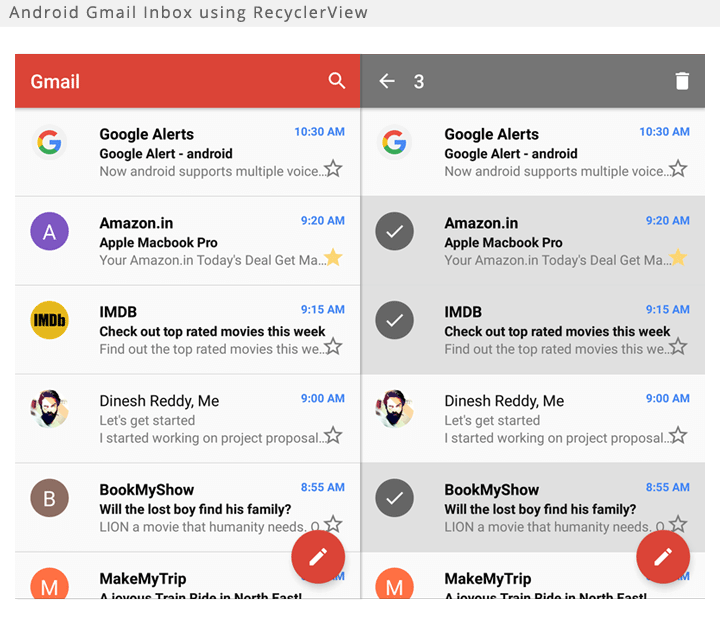
Whats Next?
This article covers everything but one thing is missing i.e adding Swipe to delete and undo functionalities. But don’t worry, the next article explains adding Swipe Delete and Undo to RecyclerView.
